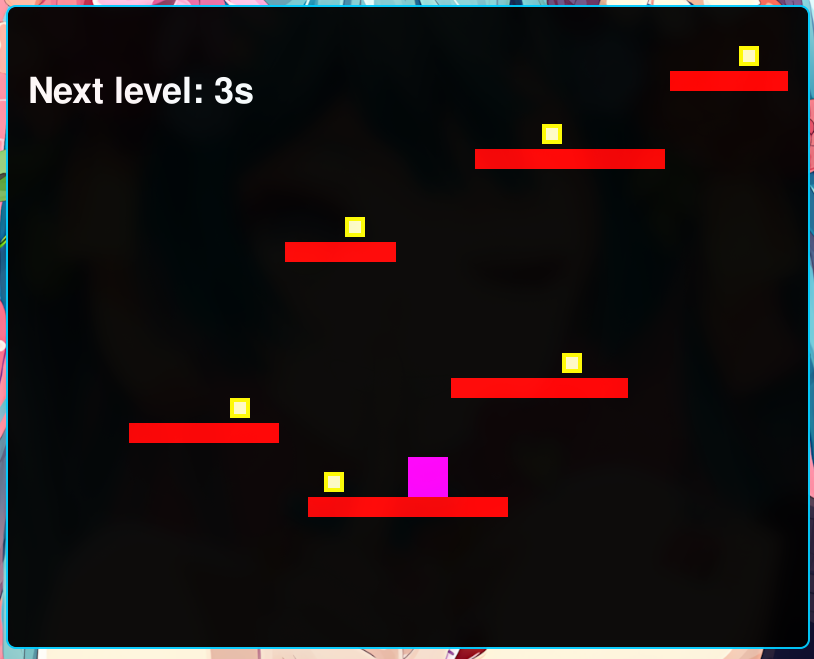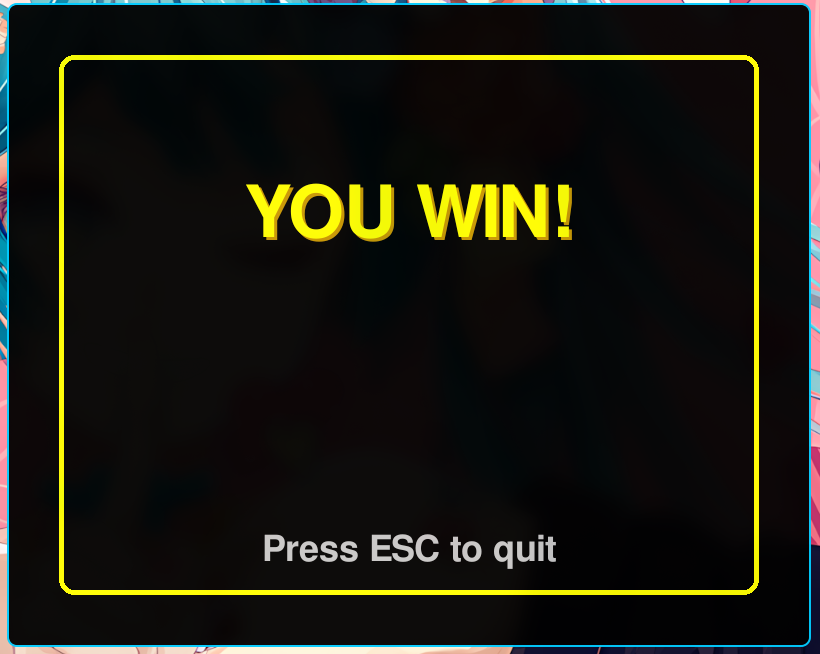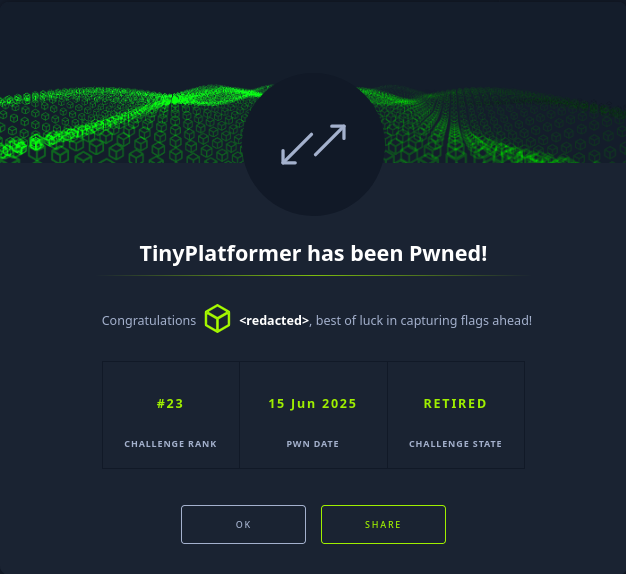TinyPlatformer
- Author
-
0x42697262
- Category
-
Reversing
- Difficulty
-
Easy
- Play Date
-
2025/06/15 - 2025/06/15
Details
There is only 1 file in this challenge.
$ ls -la -rwxr-xr-x 1 chicken chicken 17271136 May 15 14:11 TinyPlatformer*
What to expect?
-
A pygame compiled binary through PyInstaller
-
A type of Constraint satisfaction problem
|
Download the challenge here: TinyPlatformer.zip Make sure the SHA-256 hash matches the original in the HackTheBox challenge website. |
Solution
I always tend to check the file type with file command.
It doesnt do much but makes me feel I get a foothold or something.
$ file TinyPlatformer TinyPlatformer: ELF 64-bit LSB executable, x86-64, version 1 (SYSV), dynamically linked, interpreter /lib64/ld-linux-x86-64.so.2, for GNU/Linux 2.6.24, BuildID[sha1]=75f8346ea2dbfaafcc12f6682d4424f06b9a8ddd, stripped
Oh, it’s a stripped binary this time. Let me see what’s inside the strings.
$ strings TinyPlatformer ... bpygame/_freetype.cpython-37m-x86_64-linux-gnu.so bpygame/base.cpython-37m-x86_64-linux-gnu.so bpygame/bufferproxy.cpython-37m-x86_64-linux-gnu.so bpygame/color.cpython-37m-x86_64-linux-gnu.so bpygame/constants.cpython-37m-x86_64-linux-gnu.so bpygame/display.cpython-37m-x86_64-linux-gnu.so bpygame/draw.cpython-37m-x86_64-linux-gnu.so bpygame/event.cpython-37m-x86_64-linux-gnu.so bpygame/fastevent.cpython-37m-x86_64-linux-gnu.so bpygame/font.cpython-37m-x86_64-linux-gnu.so bpygame/image.cpython-37m-x86_64-linux-gnu.so bpygame/imageext.cpython-37m-x86_64-linux-gnu.so bpygame/joystick.cpython-37m-x86_64-linux-gnu.so bpygame/key.cpython-37m-x86_64-linux-gnu.so bpygame/mask.cpython-37m-x86_64-linux-gnu.so bpygame/math.cpython-37m-x86_64-linux-gnu.so bpygame/mixer.cpython-37m-x86_64-linux-gnu.so bpygame/mixer_music.cpython-37m-x86_64-linux-gnu.so bpygame/mouse.cpython-37m-x86_64-linux-gnu.so bpygame/pixelarray.cpython-37m-x86_64-linux-gnu.so bpygame/pixelcopy.cpython-37m-x86_64-linux-gnu.so bpygame/rect.cpython-37m-x86_64-linux-gnu.so bpygame/rwobject.cpython-37m-x86_64-linux-gnu.so bpygame/scrap.cpython-37m-x86_64-linux-gnu.so bpygame/surface.cpython-37m-x86_64-linux-gnu.so bpygame/surflock.cpython-37m-x86_64-linux-gnu.so bpygame/time.cpython-37m-x86_64-linux-gnu.so bpygame/transform.cpython-37m-x86_64-linux-gnu.so xFreeSansBold.ttf xbase_library.zip xpygame/freesansbold.ttf xpygame/pygame_icon.bmp zPYZ-00.pyz ...
I noticed there’s pygame indicating this might be a compiled Python game using pygame.
Although I do not know how tool is being used to compile the code.
There’s four possible tools used to package this game:
-
PyInstaller
-
cx_Freeze
-
Nuitka
-
py2exe (but this is for windows)
Running
But I haven’t even opened the game yet. So, I ran it and see what it does.

It looks like simple game. I thought the controls were WASD but it turns out to be arrow keys and the space bar.
7 seconds was plenty of time to complete each level. There were 3 levels in total.

Time to close the game since there were no print statements in the console. I only saw the word pygame and the Python version used.

Checking for the tool used to package
I need to know how it’s being compiled so first I checked for PyInstaller indicators using strings again.
$ strings TinyPlatformer | grep -i pyi Error copying %s _pyi_main_co _PYI_ONEDIR_MODE _PYI_PROCNAME Cannot open PyInstaller archive from executable (%s) or external archive (%s) PyImport_AddModule PyImport_ExecCodeModule PyImport_ImportModule Cannot dlsym for PyImport_AddModule Cannot dlsym for PyImport_ExecCodeModule Cannot dlsym for PyImport_ImportModule pyi- pyi-runtime-tmpdir pyi-bootloader-ignore-signals LOADER: failed to allocate argv_pyi: %s pYI< r<pYI PyI= PYiTb PPyiB mpyimod01_os_path mpyimod02_archive mpyimod03_importers mpyimod04_ctypes spyiboot01_bootstrap spyi_rth_subprocess spyi_rth_pkgutil spyi_rth_inspect spyi_rth_pkgres
Those pyi-, pyimod, and pyi-runtime strings tells me:
-
The Python code is embedded in a PyInstaller archive inside that ELF.
-
The code is most likely in .pyc (compiled Python) format inside a PYZ archive.
I don’t know what tool to decompile PyInstaller so I looked it up online and found pyinstxtractor.
Extracting with pyinstxtractor
After cloning the repository, I ran it and got the extracted python compiled files.
$ python pyinstxtractor/pyinstxtractor.py TinyPlatformer [+] Processing TinyPlatformer [+] Pyinstaller version: 2.1+ [+] Python version: 3.7 [+] Length of package: 17223302 bytes [+] Found 108 files in CArchive [+] Beginning extraction...please standby [+] Possible entry point: pyiboot01_bootstrap.pyc [+] Possible entry point: pyi_rth_subprocess.pyc [+] Possible entry point: pyi_rth_pkgutil.pyc [+] Possible entry point: pyi_rth_inspect.pyc [+] Possible entry point: pyi_rth_pkgres.pyc [+] Possible entry point: main.pyc [!] Warning: This script is running in a different Python version than the one used to build the executable. [!] Please run this script in Python 3.7 to prevent extraction errors during unmarshalling [!] Skipping pyz extraction [+] Successfully extracted pyinstaller archive: TinyPlatformer You can now use a python decompiler on the pyc files within the extracted directory
Cool! Here’s all the extracted files. Although I just need the script.
It’s either on main.pyc or struct.pyc.
I bet it’s on the main python script.
$ ls -la total 38292 drwxr-xr-x 6 chicken chicken 4096 Jun 15 07:35 ./ drwxr-xr-x 5 chicken chicken 94 Jun 15 06:30 ../ -rw-r--r-- 1 chicken chicken 795898 Jun 15 08:39 base_library.zip -rw-r--r-- 1 chicken chicken 359272 Jun 15 08:39 FreeSansBold.ttf -rw-r--r-- 1 chicken chicken 66784 Jun 15 08:39 libbz2.so.1.0 -rw-r--r-- 1 chicken chicken 2662388 Jun 15 08:39 libcrypto.so.1.0.0 drwxr-xr-x 2 chicken chicken 4096 Jun 15 06:22 lib-dynload/ -rw-r--r-- 1 chicken chicken 30896 Jun 15 08:39 libffi.so.6 -rw-r--r-- 1 chicken chicken 1741304 Jun 15 08:39 libFLAC-bf6d1292.so.8.3.0 -rw-r--r-- 1 chicken chicken 3621760 Jun 15 08:39 libfreetype-2d39c124.so.6.17.1 -rw-r--r-- 1 chicken chicken 142552 Jun 15 08:39 libjpeg-bd53fca1.so.62.0.0 -rw-r--r-- 1 chicken chicken 308648 Jun 15 08:39 libmikmod-fabcac29.so.2.0.4 -rw-r--r-- 1 chicken chicken 84064 Jun 15 08:39 libogg-b51fbe74.so.0.8.4 -rw-r--r-- 1 chicken chicken 959776 Jun 15 08:39 libpng16-b14e7f97.so.16.37.0 -rw-r--r-- 1 chicken chicken 10581856 Jun 15 08:39 libpython3.7m.so.1.0 -rw-r--r-- 1 chicken chicken 265456 Jun 15 08:39 libreadline.so.6 -rw-r--r-- 1 chicken chicken 9249688 Jun 15 08:39 libSDL2-2-d6813302.0.so.0.14.0 -rw-r--r-- 1 chicken chicken 674808 Jun 15 08:39 libSDL2_image-2-554041b7.0.so.0.2.3 -rw-r--r-- 1 chicken chicken 589200 Jun 15 08:39 libSDL2_mixer-2-5dc902ba.0.so.0.2.2 -rw-r--r-- 1 chicken chicken 153552 Jun 15 08:39 libSDL2_ttf-2-dd80ed71.0.so.0.14.1 -rw-r--r-- 1 chicken chicken 514261 Jun 15 08:39 libssl.so.1.0.0 -rw-r--r-- 1 chicken chicken 389776 Jun 15 08:39 libtiff-97e44e95.so.3.8.2 -rw-r--r-- 1 chicken chicken 159200 Jun 15 08:39 libtinfo.so.5 -rw-r--r-- 1 chicken chicken 18896 Jun 15 08:39 libuuid.so.1 -rw-r--r-- 1 chicken chicken 240344 Jun 15 08:39 libvorbis-205f0f59.so.0.4.8 -rw-r--r-- 1 chicken chicken 63136 Jun 15 08:39 libvorbisfile-f207f3a6.so.3.3.7 -rw-r--r-- 1 chicken chicken 3627752 Jun 15 08:39 libwebp-582c46b3.so.7.1.0 -rw-r--r-- 1 chicken chicken 87848 Jun 15 08:39 libz-a147dcb0.so.1.2.3 -rw-r--r-- 1 chicken chicken 92720 Jun 15 08:39 libz.so.1 -rw-r--r-- 1 chicken chicken 9558 Jun 15 08:39 main.pyc (1) drwxr-xr-x 2 chicken chicken 35 Jun 15 07:03 __pycache__/ drwxr-xr-x 2 chicken chicken 4096 Jun 15 06:22 pygame/ -rw-r--r-- 1 chicken chicken 1378 Jun 15 08:39 pyiboot01_bootstrap.pyc -rw-r--r-- 1 chicken chicken 1700 Jun 15 08:39 pyimod01_os_path.pyc -rw-r--r-- 1 chicken chicken 8737 Jun 15 08:39 pyimod02_archive.pyc -rw-r--r-- 1 chicken chicken 17760 Jun 15 08:39 pyimod03_importers.pyc -rw-r--r-- 1 chicken chicken 3640 Jun 15 08:39 pyimod04_ctypes.pyc -rw-r--r-- 1 chicken chicken 676 Jun 15 08:39 pyi_rth_inspect.pyc -rw-r--r-- 1 chicken chicken 4179 Jun 15 08:39 pyi_rth_pkgres.pyc -rw-r--r-- 1 chicken chicken 1081 Jun 15 08:39 pyi_rth_pkgutil.pyc -rw-r--r-- 1 chicken chicken 811 Jun 15 08:39 pyi_rth_subprocess.pyc -rw-r--r-- 1 chicken chicken 1556675 Jun 15 08:39 PYZ-00.pyz drwxr-xr-x 2 chicken chicken 6 Jun 15 06:22 PYZ-00.pyz_extracted/ -rw-r--r-- 1 chicken chicken 297 Jun 15 08:39 struct.pyc (2)
| 1 | Probably the entire game |
| 2 | Probably some data (spoiler: there’s nothing worth it inside) |
Next is I need to figure out how to decompile the compiled python script. Quick searches online gave me 3 options:
I checked decompile3 first and noticed it was good enough.
I didn’t stop there so I checked pycdc as well. Although I still need to compile it since it’s written in C++, so I skipped it.
I checked uncompyle6 as well, which is written by the same person of decompile3, and it turns out decompile3 is the refactored version of uncompyle6. I can choose either of the two but went with uncompyle6 because it’s recently been updated compared to months of no updates for decompile3.
Decompiling with uncompyle6
I ran uncompyle6 to main.pyc.
$ uncompyle6 main.pyc > main.py
This outputs the source code into a file.
Reading the source code of main.py
|
The decompiled source code of |
It took me some time, probably an hour, to understand the flow of the code. To skip some headaches explaining my experience, the code below is what’s needed to grab the flag of this challenge.
secret_flag = False
if self.win:
...
secrets = [
[self.player.secret[i] for i in range(6)]]
secrets += [[self.player.secret[i] for i in range(6, 11)]]
secrets += [[self.player.secret[i] for i in range(11, len(self.player.secret))]]
secrets = [secrets[0][0] > secrets[0][2], secrets[0][1] < secrets[0][4], secrets[0][2] > secrets[0][5], secrets[0][3] > secrets[0][4], secrets[0][5] > secrets[0][3],
secrets[1][0] > secrets[1][4], secrets[1][1] < secrets[1][4], secrets[1][2] < secrets[1][3], secrets[1][3] < secrets[1][1],
secrets[2][0] > secrets[2][1], secrets[2][2] < secrets[2][1], secrets[2][2] > secrets[2][3]]
secret_flag = secret_flag not in secrets
...
if secret_flag:
key = "".join([str(x) for x in self.player.secret]).encode()
ciph = b'}dvIA_\x00FV\x01A^\x01CoG\x03BD\x00]SO'
flag = bytes((ciph[i] ^ key[i % len(key)] for i in range(len(ciph)))).decode()I deleted some parts of the code that’s not needed.
The encrypted flag is stored in ciph variable.
The key is based from the collected COLLECTIBLES's index encoded as a byte string.
The flag is stored in flag variable.
The collectibles are the ones the players collect in the game.
Here’s what I found out after reading the source code:
- self.player.secret
-
A list of integers forming the index of the collected COLLECTIBLES.
- collectibles
-
Object the player collects in the game.
- secrets
-
A group of lists containing the indexes of collectibles and transforms into a boolean lists.
- secret_flag
-
A check if secrets are all True that satisfies the conditions of secrets.
So, the flow goes like this:
For each group in the list, there is a corresponding constraint.
secrets[0][0] > secrets[0][2] secrets[0][1] < secrets[0][4] secrets[0][2] > secrets[0][5] secrets[0][3] > secrets[0][4] secrets[0][5] > secrets[0][3]
secrets[1][0] > secrets[1][4] secrets[1][1] < secrets[1][4] secrets[1][2] < secrets[1][3] secrets[1][3] < secrets[1][1]
secrets[2][0] > secrets[2][1] secrets[2][2] < secrets[2][1] secrets[2][2] > secrets[2][3]
Once the constraints are applied, secrets (which is a list of booleans) should all be True.
Otherwise, our decryption key is incorrect.
Finding the Secret key
There are two ways to acquire the list of indexes.
First is to modify the source code and add a print statement when the game ends.
Second is to sort the COLLECTIBLES based on its Y-coordinate.
I did the first method and was able to get this.
[0, 4, 5, 1, 3, 2, 0, 3, 1, 2, 4, 3, 0, 2, 1]
COLLECTIBLES = [
[ (316, 465), (337, 210), (731, 39), (534, 117), (222, 391), (554, 346) ],
[ (380, 415), (417, 252), (570, 138), (197, 316), (358, 65) ],
[ (164, 289), (567, 50), (371, 144), (461, 442) ]
]COLLECTIBLES is just a list of tuples that contains two items, X and Y coordinates.
0 (316, 465) 1 (337, 210) 2 (731, 39) 3 (534, 117) 4 (222, 391) 5 (554, 346) 0 (380, 415) 1 (417, 252) 2 (570, 138) 3 (197, 316) 4 (358, 65) 0 (164, 289) 1 (567, 50) 2 (371, 144) 3 (461, 442)
When these are sorted based on its Y-coordinate (the 2nd index), I was able to obtain the following:
2 (731, 39) 3 (534, 117) 1 (337, 210) 5 (554, 346) 4 (222, 391) 0 (316, 465) 4 (358, 65) 2 (570, 138) 1 (417, 252) 3 (197, 316) 0 (380, 415) 1 (567, 50) 2 (371, 144) 0 (164, 289) 3 (461, 442)
But this returns: [2, 3, 1, 5, 4, 0, 4, 2, 1, 3, 0, 1, 2, 0, 3].
So it’s wrong.
Wait, notice that it’s reversed for each group. Ah, now that makes sense.
That’s because of how PyGame works: Y-axis grows downwards.
So, the actual sorted COLLECTIBLES looks like this:
0 (316, 465) 4 (222, 391) 5 (554, 346) 1 (337, 210) 3 (534, 117) 2 (731, 39) 0 (380, 415) 3 (197, 316) 1 (417, 252) 2 (570, 138) 4 (358, 65) 3 (461, 442) 0 (164, 289) 2 (371, 144) 1 (567, 50)
Finding the correct order of the key
Now, I should be able to decrypt the ciphertext to obtain the flag!
Except all I got is MPCxrm0ug3um1q^w7wu3oc| which is very far from HackTheBox’s flag format.
Well, that’s because I forced my way to decrypt the ciphertext even though the order was incorrect.
When the constraints was applied, secrets contained at least one value of False.
Using the given key results to this check:
[False, False, True, False, True, False, True, True, True, True, False, True]
I didn’t want to manually find the constraints so I asked ChatGPT to solve it for me. In hindsight, I should’ve used Microsft Z3, a SAT solver.
Anyways, I got the key.
[5, 0, 4, 2, 1, 3, 4, 2, 0, 1, 3, 3, 2, 1, 0]
Which resulted everything into True!
Obtaining the Flag
I made a snippet of code from the game and only taking the code that’s involved in obtaining the flag.
secret_flag = False
secret = [5, 0, 4, 2, 1, 3, 4, 2, 0, 1, 3, 3, 2, 1, 0]
secrets = [[secret[i] for i in range(6)]]
secrets += [[secret[i] for i in range(6, 11)]]
secrets += [[secret[i] for i in range(11, len(secret))]]
secrets = [
secrets[0][0] > secrets[0][2], secrets[0][1] < secrets[0][4], secrets[0][2] > secrets[0][5], secrets[0][3] > secrets[0][4], secrets[0][5] > secrets[0][3],
secrets[1][0] > secrets[1][4], secrets[1][1] < secrets[1][4], secrets[1][2] < secrets[1][3], secrets[1][3] < secrets[1][1],
secrets[2][0] > secrets[2][1], secrets[2][2] < secrets[2][1], secrets[2][2] > secrets[2][3]
]
secret_flag = secret_flag not in secrets
key = "".join([str(x) for x in secret]).encode()
ciph = b'}dvIA_\x00FV\x01A^\x01CoG\x03BD\x00]SO'
flag = bytes((ciph[i] ^ key[i % len(key)] for i in range(len(ciph)))).decode()
print(flag)
Challenge complete.
Conclusion
This is a pretty nice challenged. I thought I would have a harder time figuring out how to grab the flag. Thought that I’d need to keep playing the game or have to spam print statements everywhere.
Turns out, I just need to properly understand the code. And that’s how I captured this challenge.
Although, I should’ve thought of using Z3 Theorem Prover from Microsoft Research. Oh well, let’s just say it’s a good experience and at least now know what to use next time.